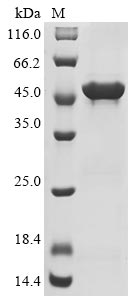Recombinant hamster polyomavirus major capsid protein VP1 generation begins with isolating the target gene, which covers the full-length VP1 (1-372aa). This gene is linked with an N-terminal 10xHis-tag and C-terminal Myc-tag gene and then cloned into an expression vector, which is transfected into E. coli cells for protein expression. The recombinant VP1 protein is purified from the cell lysate through affinity chromatography. Its purity is over 85% as determined by SDS-PAGE.
The HaPyV VP1 protein is the major capsid protein of the Hamster Polyomavirus. Research has shown that the HaPyV VP1 protein can be utilized as a carrier for creating autologous, chimeric, and mosaic VLPs, which are valuable in producing epitope-specific antibodies [1]. The authentic HaPyV VP1 protein consists of 384 amino acid residues and has been successfully used in the assembly of VLPs [2]. Furthermore, the HaPyV VP1 protein has been exploited for generating chimeric VLPs with foreign epitopes or pseudotype VLPs when co-expressed with the minor capsid protein VP2, demonstrating its versatility in VLP production [3].
Studies have highlighted the immunogenicity of HaPyV VP1-derived VLPs, showcasing their ability to induce specific immune responses. These VLPs have been used as carriers for cytotoxic T-cell epitopes, tumor-associated epitopes, and other antigenic sequences, emphasizing their potential in vaccine development and immunotherapy [4]. Additionally, the HaPyV VP1 protein has been instrumental in the production of pseudotype VLPs displaying neutralizing antibody fragments, further underlining its significance in antibody generation [5].
References:
[1] B. Jandrig, H. Krause, W. Zimmermann, E. Vasiliūnaitė, A. Gedvilaitė, & R. Ulrich, Hamster polyomavirus research: past, present, and future, Viruses, vol. 13, no. 5, p. 907, 2021. https://doi.org/10.3390/v13050907
[2] T. Voronkova, A. Kazāks, V. Ose, M. Özel, S. Scherneck, P. Pumpenset al., Hamster polyomavirus-derived virus-like particles are able to transfer in vitro encapsidated plasmid dna to mammalian cells, Virus Genes, vol. 34, no. 3, p. 303-314, 2007. https://doi.org/10.1007/s11262-006-0028-1
[3] M. Pleckaityte, C. Bremer, A. Gedvilaite, I. Kucinskaite-Kodze, D. Glebe, & A. Zvirbliene, Construction of polyomavirus-derived pseudotype virus-like particles displaying a functionally active neutralizing antibody against hepatitis b virus surface antigen, BMC Biotechnology, vol. 15, no. 1, 2015. https://doi.org/10.1186/s12896-015-0203-3
[4] D. Dorn, R. Lawatscheck, A. Zvirbliene, E. Aleksaitė, G. Pecher, K. Sasnauskaset al., Cellular and humoral immunogenicity of hamster polyomavirus-derived virus-like particles harboring a mucin 1 cytotoxic t-cell epitope, Viral Immunology, vol. 21, no. 1, p. 12-26, 2008. https://doi.org/10.1089/vim.2007.0085
[5] M. Pleckaityte, A. Zvirbliene, I. Sezaite, & A. Gedvilaite, Production in yeast of pseudotype virus-like particles harboring functionally active antibody fragments neutralizing the cytolytic activity of vaginolysin, Microbial Cell Factories, vol. 10, no. 1, 2011. https://doi.org/10.1186/1475-2859-10-109






